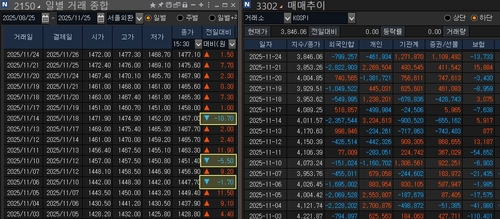(Seoul=Yonhap Infomax) Ji Yeon Kim – Despite record-high net selling of South Korean equities by foreign investors in recent weeks, the traditional correlation between foreign outflows and a rising dollar-won (USD/KRW) exchange rate has notably weakened, drawing market attention.
Movements in the Seoul foreign exchange market have increasingly reflected a web of complex supply-demand factors, breaking the conventional pattern where foreign equity selling directly fuels upward pressure on the won-dollar rate.
According to Yonhap Infomax’s daily USD/KRW trading summary (screen no. 2150), the exchange rate climbed by 48.30 won (3.38%) from 1,428.80 won on the 3rd to 1,477.10 won on the 24th of this month, based on regular session closing prices.
During the same period, Yonhap Infomax’s trading trends (screen no. 3302) show that foreign investors were net sellers of over 13 trillion won ($9.8 billion) in the KOSPI market. Should this trend persist for the remaining three trading days, it would mark the largest monthly net foreign outflow on record.

Notably, the recent divergence between exchange rate movements and foreign investor flows stands out. Traditionally, foreign equity selling in the KOSPI market leads to custodial dollar buying, exerting upward pressure on the exchange rate. However, on days such as the 11th, 13th, and 17th of this month, when foreigners were net buyers, the USD/KRW still rose. Conversely, on the 6th, 10th, and 14th—when the exchange rate fell—foreigners were net sellers.
“On the 21st, for example, foreigners sold over 2 trillion won in equities intraday, yet the exchange rate remained flat,” said a bank FX dealer. “It appears that foreign equity selling did not have a significant impact on the exchange rate.”
Analysts attribute this decoupling in part to changes in foreign exchange settlement strategies. “Some foreign investors hedge currency risk at the time of equity purchase,” explained an FX market specialist. “Funds entering via forward contracts generate little spot dollar demand when exiting, limiting immediate exchange rate impact.”
This suggests that when foreign investors use derivatives such as forwards or FX swaps for hedging and conversion, dollar demand is dispersed, reducing direct pressure on the spot market. As a result, the impact on the exchange rate is muted.
Additionally, some foreign investors may temporarily reallocate proceeds from equity sales into local won-denominated assets such as bonds or money market funds (MMFs), further weakening the link between equity outflows and the exchange rate.
This month, a range of factors beyond foreign investor flows have influenced the won-dollar rate, including:
- Increased dollar demand from residents’ overseas investments
- Exporters delaying dollar sales (nego)
- Corporate investments in the US
- Pressure on the won from global yen weakness
- Accumulation of long positions in the FX market
Verbal intervention by FX authorities has also heightened volatility, further complicating the relationship between the exchange rate and foreign investor flows this month.
Looking ahead, some analysts warn that persistent won weakness amid risk-off sentiment could trigger renewed foreign equity outflows. “If custodial funds from foreign equity selling are converted en masse into dollars, it could drive the exchange rate higher,” said Min Hyuk Lee, economist at KB Kookmin Bank.
SK Securities noted that recent foreign selling has been concentrated in the semiconductor sector. “If even optimism for semiconductors fades amid a weak won, foreign equity selling could become systematic,” the firm said, adding that “stabilizing concerns over an AI bubble is necessary.”
jykim2@yna.co.kr
(End)
Table: USD/KRW Exchange Rate Movements (2025-11)
| Date | Exchange Rate (USD/KRW) |
|---|---|
| 2025-11-24 | 1,477.1000 |
| 2025-11-03 | 1,428.8000 |
Trend Analysis: The USD/KRW exchange rate rose by 3.38% in November, reaching a recent high of 1,477.10, despite record foreign equity outflows. This decoupling signals a shift in market dynamics, with hedging strategies and domestic factors diluting the traditional correlation between foreign stock selling and currency depreciation.
Copyright © Yonhap Infomax Unauthorized reproduction and redistribution prohibited.

